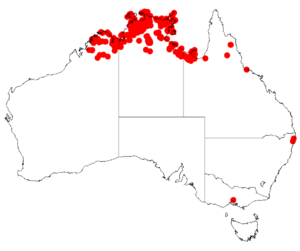Western salwood facts for kids
Quick facts for kids Western salwood |
|
|---|---|
 |
|
| A. lamprocarpa seed pods | |
| Scientific classification | |
| Genus: |
Acacia
|
| Species: |
lamprocarpa
|
 |
|
| Occurrence data from AVH | |
The Western Salwood (scientific name: Acacia lamprocarpa) is a type of tree. It belongs to the Acacia family, which is a large group of trees and shrubs. This tree is special because it only grows in northern Australia.
Contents
About the Western Salwood Tree
The Western Salwood tree has bark that looks like paper and peels off. It is usually yellow-brown. These trees can grow quite tall, from 4 to 15 metres (13 to 49 ft) high. Their main trunk is usually not very thick, less than 30 centimetres (12 in) across.
Leaves and Flowers
The tree has smooth, thin branches that often hang down. Its leaves are actually called phyllodes. They are grey-green and shaped like blades. Each phyllode is about 7.5 to 14.5 centimetres (3.0 to 5.7 in) long and 0.9 to 1.8 cm (0.35 to 0.71 in) wide.
The Western Salwood blooms between April and June. It produces pretty pale yellow flowers. These flowers grow in spikes, which can be up to 5 cm (2.0 in) long. You'll often find one to five of these flower spikes growing together on the branches.
Seed Pods and Seeds
After the flowers bloom, the tree grows woody seed pods. These pods are long and narrow, and they often twist into a spiral shape. Each pod can be 2 to 12.5 cm (0.79 to 4.92 in) long and 1.4 to 3.2 cm (0.55 to 1.26 in) wide. Inside the pods are shiny black seeds. The seeds are not all the same shape. They are about 4 to 7 mm (0.157 to 0.276 in) long and half as wide.
Tree Classification
The Western Salwood was first officially described in 1927. A botanist named Otto Karl Anton Schwarz gave it its scientific name. For a short time in 2003, it was called Racosperma lamprocarpum. But by 2006, it was moved back to the Acacia group. Another name for this tree is Acacia aulacocarpa.
Where the Western Salwood Lives
You can find the Western Salwood tree in several parts of northern Australia. It grows in Western Australia, the Northern Territory, and the Gulf Country in north-east Queensland.
In Western Australia, it grows in a small area called the Kimberley region. Here, it prefers sandy soils that are on top of sandstone or laterite rock. The tree is often found in or near monsoon forests. It also grows in open forest areas, especially in sandstone gorges.

